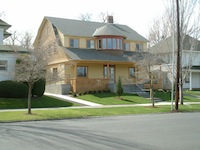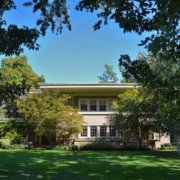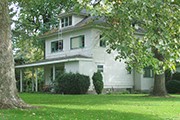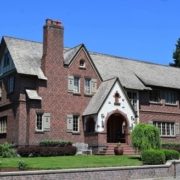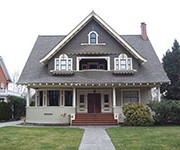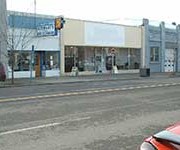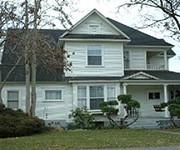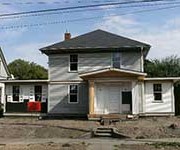History of 26 Boyer Avenue, Walla Walla, WA
Property Description:
Beginning at a point on the Southerly line of Boyer Avenue 301.5 feet, more or less, Easterly measured along said Southerly line of Boyer Avenue, from the intersection of the Southerly line of Boyer Avenue with the Easterly line of Palouse Street, in the City of Walla Walla, being the Northwest corner of a strip of land 77.73 feet frontage on Boyer Avenue deeded by D. S. Baker and wife to John F. Boyer under date of January 29th, 1885; and running thence Westerly along the Southerly line of Boyer Avenue 60 feet; thence Southerly and at right angles to the Southerly line of Boyer Avenue, to a point in the Northerly line of Lot Twelve (12) in Block Two (2) of Boyer Grove Addition to the City of Walla Walla, according to the official plat thereof of record in the office of the Auditor of said County of Walla Walla; thence southeasterly along the Northerly line of Lots Twelve (12) and Eleven (11) in Block Two (2) of Boyer Grove Addition to the City of Walla Walla to a point in the Northerly line of said Lot Eleven (11), made by an intersection of a line drawn from the point of beginning Southerly and at right angles to the Southerly line of Boyer Avenue until it intersects said Northerly line of said Lot Eleven (11), thence Northerly 364.00 feet, more or less to the place of beginning.
EXCEPTING therefrom that portion lying South of the North line of the Mill Creek Flood Control Bulkhead and/or Retaining wall; situated in the City of Walla Walla, State of Washington.
Title History:
Washington Territory was created in 1853. The new legislature created Walla Walla County in 1854 which stretched from the crest of the Cascade Mountains to the crest of the Rocky Mountains in the present states of Washington, Idaho and Montana. In 1855 an Indian council was held on the banks of Mill Creek at the present site of Walla Walla to purchase land from the Indians. The Yakimas, Cayuses and Walla Wallas were dissatisfied with the treaties and war followed. Missionaries, former French-Canadian employees of the Hudson Bay Company trading post at Wallula, and soldiers at the military Fort Walla Walla were the primary European occupants of the area prior to 1859 when it was opened for settlement. All of the land in this area was acquired from the Cayuse and Walla Walla Indian tribes by the U.S. Government in a treaty signed on June 9, 1855 in Walla Walla, and not ratified until March 8, 1859 by President James Buchanan.
Walla Walla was originally laid out by County Surveyor H. H. Case in 1859, before its formal incorporation as a city in 1862, as a one-quarter mile square with its eastern side centered on the point where Main Street crossed Mill Creek (at roughly the point where it does now). The City of Walla Walla received a Trustee Townsite from the U. S. Government which consisted of 80 acres issued on July 20, 1869 by the Vancouver, Washington Territory, District Land Office.
This property is part of the oldest U.S. Patent in Walla Walla. On September 10, 1861 Andrew J. Cain and Cornelius Kelly filed a patent on 160 acres under the Script Warrant Act of 1855 northeast of the original City of Walla Walla town site. During 1862, A. J. Cain surveyed Cain’s Addition to the City (this survey was rerecorded on May 11, 1865, following a disastrous fire which destroyed most of the county’s earlier records).
A. J. Cain was a lawyer in Walla Walla between 1860 and 1873. He was elected on the Democratic ticket as prosecuting attorney of Walla Walla County in 1868. He later moved to Dayton and in September 1874 began publication of the Dayton News, a weekly Democratic newspaper. He became known as the “Father of Columbia County” as a result of his leading role in the formation of that county.
The first legal transaction involving this property recorded in the local records was a deed to this property in 1862 from A. J. and Emma Cain to John F. Boyer. Boyer had been born in Kentucky in 1824 and came west with the gold rush in 1849. After success in California he returned east in 1852 and married Dorsey Baker’s sister in 1853. In 1862 Boyer arrived in Walla Walla to become Dr. Baker’s partner in the merchandising business. In 1889 Mr. Boyer became the first president of Baker Boyer National Bank and continued in this position until his death in 1897. He and Mr. Baker were also very active in the developing community. He served as county treasurer for 12 years and as a trustee of Whitman College for 30 years. He and Baker were also very involved in real estate investments and frequently Boyer was a silent partner in Baker’s real estate purchases. Boyer purchased this property the first year he lived in Walla Walla, with Baker as his silent partner. Boyer built his residence about 1880 on land at Boyer and Otis Streets where Baker Faculty Center is now located. Boyer’s home was moved across Otis Street to its present location at 401 Cypress in 1903. It is now Whitman College’s German House. The current Boyer Avenue was called Boyer’s Avenue on the earliest fire maps. Multiple legal transactions of which this property was some small part involved Boyer, Baker and their heirs for the next 40 years.
In 1900 this property was transferred to the Baker Loan and Investment Company who sold it to William A. Ferguson on February 26, 1902 for $1400. On March 5, 1906 Mr. Ferguson gave full separate title for this property to his wife, E. Margaret Ferguson. On September 8, 1924 the Baker Loan and Investment Company signed a Quit Claim Deed giving E. Margaret Preston (formerly Ferguson) a clear title to this property. Through an unrecorded contract Margaret Preston sold this property to Truett and Mollie Farmer on August 9, 1924. Truett Farmer died on December 20, 1924 and his son Sam Farmer, as executor of his father’s estate, gave an Assignment of Contract on January 27, 1926 to J. W. Cookerly. On January 28, 1926 Mollie, Sam and Catherine Farmer gave a Quit Claim Deed to J. W. Cookerly. On February 18, 1926 E. Margaret and Charles B. Preston gave a Warranty Deed to J. W. Cookerly. J. W. and Mattie C. Cookerly transferred a Life Estate to themselves on March 2, 1936. On December 20, 1938 they transferred ownership to their daughter Hazel Tuttle, a widow, for “love and affection.” Mrs. Tuttle died on April 8, 1964. Betty Ann Tuttle, widow of Hazel Tuttle’s son John C. Tuttle and executor of his estate, sold this property to the Board of Trustees of Whitman College on April 30, 1992.
Occupant History:
The presumed builder and first occupant of this residence was William A. Ferguson who purchased this property in early 1902. He was first listed at this address in the 1904 city directory but there was no 1903 directory. The address at that time was 16 Boyer, later changed to 26 Boyer. Mr. Ferguson ran a dry goods store at 28 E. Main in 1902. In 1905 he changed the name of his store to The Bee Hive, which became a long time landmark at First and Main Streets in downtown Walla Walla (currently housing Starbucks and Coffee Perk on the main floor and The Bee Hive salon and offices above). In 1906 Ferguson and his wife divorced and she received title to the home. E. Margaret Ferguson subsequently married Charles Bliss Preston, son of William Preston, president of Preston-Shaffer Milling Co. of Waitsburg. They were never listed as residents at 26 Boyer. In the 1921 city directory Truett and Mollie Farmer were listed as living at 26 Boyer, prior to their purchase of the house in 1924. Mollie worked at the Walla Walla Hotel and Truett worked as a chauffeur until his death in 1924.
Unlike early occupants, the following residents and their heirs occupied this home for the next 66 years. John and Mattie Cookerly arrived in Walla Walla in 1888 and operated undertaking parlors at 7 1/2 S. First and 19 S. Spokane. The Cookerlys had purchased John Brewer’s residence next door to this house at 34 Boyer on June 1, 1925 where they established Cookerly and Funk Funeral Home. They bought this house in 1926 as their residence. Both John and Mattie had families from prior marriages. John’s son Grova was City Engineer for Walla Walla from 1930-1954. Mattie had three children, William, Hazel and Erima Coleman. Hazel married Ralph Tuttle who ran the Franklin Motor Car Co. at the northwest corner of Alder and Spokane Streets. He also ran Ralph Tuttle’s Motor Sales Co. and Service Station at Main and Colville Streets. In 1915, he had ordered “the largest single shipment of high-grade cars ever made to any dealer in the United States.” Tuttle died in 1928. Tuttle’s widow Hazel raised their son, John Coleman Tuttle, in her parents’ home at 26 Boyer. John Cookerly died in 1941. Hazel continued to live here until her death in 1964. John Tuttle became a Walla Walla lawyer and superior court judge. After 1964, the property continued to be owned by John Tuttle as a rental with a variety of tenants.
Extensive renovation has now begun on this house. The open walls reveal that the building had significant prior alterations. Workmen have found numerous newspapers dating from 1941, suggesting a possible remodel date. Large windows in the second floor were replaced with smaller ones and many closed doorways show how a single family residence was transformed into multiple apartments. This happened often during World War II when the Walla Walla air base was operational because so many military families needed housing. The 1905 footprint of the house is largely unchanged today but it is possible to see how a back porch was enclosed and the second floor extended above it. City directories list three apartments in 1941. This was soon expanded to include six apartments (1 through 4 plus A and B). The house suffered a fire at some time and a lowered ceiling was installed in the second floor to cover it, perhaps at the time of the 1941 remodeling. The distinctive semicircular second story porch appeared to have been a sleeping porch originally but was converted to a bathroom when apartments were created. An artifact found by current workmen is a wooden shelf made from a packing crate which was addressed to John C. Tuttle, from John C. Tuttle, apparently when he came home from World War II.
Construction of the Building:
The Walla Walla County Tax Assessor’s Office lists a construction date of 1905, which this research determines to be inaccurate. No houses existed in this block on the 1894 fire map. While the footprint of the house appears on the 1905 fire map, W. A. Ferguson bought this property in early 1902 and was listed as living here in 1904. There was no 1903 city directory so it is reasonable to assume that this house was constructed circa 1902, shortly after the construction of John F. Brewer’s house next door at 34 Boyer in 1901. There are no building permits available from this time.
References:
Bennett, Robert A., Walla Walla Portrait of a Western Town 1804-1899, Pioneer Press, Walla Walla, 1980.
Bennett, Robert A., Walla Walla A Town Built to be a City 1900-1919, Pioneer Press, Walla Walla, 1982.
Bennett, Robert A., A Nice Place to Raise a Family 1920-1949, Pioneer Press, Walla Walla, 1988.
BLM Land Patent Records
Sanborn Fire Maps: 1884-1905 (with updates until 1950).
Site visit with John Porchowsky, Whitman College Project Engineer
U. S. Census records
Walla Walla City Directories: 1880-present (various publishers–not all years).
Whitman College Archives.
Mary E. Meeker ; Walla Walla 2020 Research Service PO Box 1222, Walla Walla WA 99362 August, 2009

